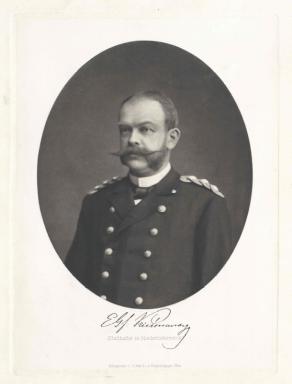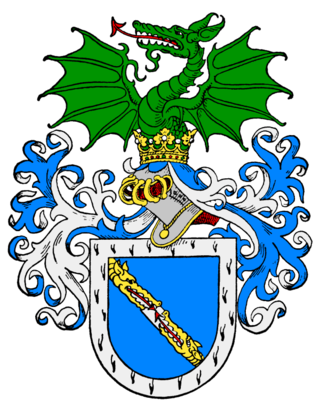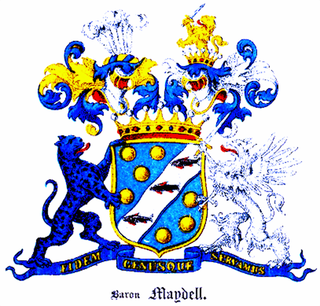History
The family was already in existence in the second half of the 12th century. One of its first demonstrable members was Thedel von Wallmoden, named in documents from 1154 onwards. An Eschwin von Wallmoden was mentioned in 1181. The Knight Templar Aschwin von Wallmoden is mentioned in 1307, on the dissolution of the Templars by Pope Clement V, at which time the Heinde herrschaft was a fiefdom of the Bishop of Hildesheim. Through marriage and inheritances, the family was able to significantly extend its property and continued into the 18th century.
The marriage of Henning von Wallmoden (1335–1393) with Agnes von Hallermund led to the uniting of both the lordly families in Heinde.
Thedel von Wallmoden († 1529), Stadthauptmann of Goslar, was the origin of both family lines. The elder line or upper house included Johan and his mother Amalie. In 1782 this line acquired from the princedom of Schwarzenberg the Reichsherrschaft Gimborn in Westphalia and on 17 January 1783 was raised by Joseph II, Holy Roman Emperor to the name of Wallmoden-Gimborn and promoted to Reichsgraf. The family ruled over Lordship of Gimborn-Neustadt, which was mediatised by the Grand Duchy of Berg in 1807. Of the first graf's descendants, the last was Graf Karl August Ludwig von Wallmoden-Gimborn, k.u.k. geheimer Rat, who died on 26 February 1883 in Prague.
The younger line or lower house has been able to retain the property of the Stammsitz, temporarily a 'Fideikommiss', right up to the present day. Also the first names Thedel has been kept up in the family to the present day.

Sayn-Wittgenstein was a county of medieval Germany, located in the Sauerland of eastern North Rhine-Westphalia.

The House of Fürstenberg is the name of a German noble family of Westphalia, which descended from Hermannus de Vorstenberg. He was a liegeman of the Archbishop of Cologne, who was among the prince electors of the Holy Roman Empire. Hermannus held a castle for his lord called Fürstenberg at Ense-Höingen in Soest; this castle would give the family its name. His son was Wilhelm von Vorstenberg, the Justiciar and Castellan of Werl.

The House of Finck von Finckenstein is a noble family classified as Uradel. It is one of the oldest Prussian aristocratic families extant, dating back to the 12th century in the Duchy of Carinthia.

Luitpold Rupprecht Heinrich Prinz von Bayern is a member and second in line of succession to the headship of the House of Wittelsbach, which reigned as Kings of Bavaria until 1918, and the head of König Ludwig Schlossbrauerei.

Erich Graf von Kielmansegg was an Austrian statesman. He served as stadtholder of Lower Austria and short time Minister-President of the Austro-Hungarian Empire in 1895.

Ludwig Georg Thedel Graf von Wallmoden was an Austrian General of the Cavalry, best known for his training of light infantry and the refinement of the Tirailleur system. As a grandson of George II of Great Britain and first cousin of George III, he is perhaps the only individual from that generation to have been photographed, within the broader British royal family.

Johann Ludwig Reichsgraf von Wallmoden-Gimborn was a German lieutenant-general and art collector.

Countess Amalie Sophie Marianne von Wallmoden-Gimborn, Countess of Yarmouth, born Amalie von Wendt was the principal mistress of King George II from the mid-1730s until his death in 1760. Born into a prominent family in the Electorate of Hanover, and married into another, in 1740 she became a naturalised subject of Great Britain and was granted a peerage for life, with the title of "Countess of Yarmouth", becoming the last royal mistress to be so honoured. She remained in England until the death in 1760 of King George II, who is believed to have fathered her second son, Johann Ludwig, Reichsgraf von Wallmoden-Gimborn. She returned to Hanover for the rest of her life, surviving the king for nearly five years.
Bernhart Otto Peter, 6th Prince of Sayn-Wittgenstein-Hohenstein is a German businessman and the current head of the Princely House of Sayn-Wittgenstein-Hohenstein.

Princess Bona of Savoy-Genoa, later Princess Bona of Bavaria, was a daughter of Prince Tommaso, Duke of Genoa and Princess Isabella of Bavaria.
Sayn-Wittgenstein-Hohenstein was a county and later principality between Hesse-Darmstadt and Westphalia.

The House of Hoyos is a prominent Austrian noble family of an ancient Castilian origin, whose members held significant political positions during the Austro-Hungarian and the German Empire.

The House of Alvensleben is an ancient, Low German (niederdeutsch) noble family from the Altmark region, whose earliest known member, Wichard de Alvensleve, is first mentioned in 1163 as a ministerialis of the Bishopric of Halberstadt. The family name derives from Alvensleben Castle. They are one of the oldest extant German aristocratic families.

The House of Asseburg, original German name von der Asseburg, is an old Lower Saxon aristocratic family which had its origin in Wolfenbüttel and Asseburg. During the 12th and 13th centuries the lords of Wolfenbüttel were able to establish their own small county, but were soon forced to give way to the Brunswick dukes of the House of Welf. Later their title was taken over by other families in the female line, and the counts of Asseburg continue to be landowners to this day.

The House of Merveldt is the name of an ancient Westphalian aristocratic family, which belongs to the German nobility of the Middle Ages. The Herrn (Lords) von Merveldt were among the oldest families in the Münsterland. Merfeld, the eponymous seat of the family, is now a neighborhood of the city of Dülmen in the District of Coesfeld in the state of North Rhine-Westphalia in Germany.

The Schlieffen family is the name of an old German noble family from Pomerania. The family, branches of which still exist today, originates in Kolberg.

The House of Egloffstein is an ancient Franconian aristocratic family (Uradel) with an eponymous family home in the hill region of Franconian Switzerland in the Bavarian province of Upper Franconia. The family first appears in the records in 1187 with a Heinrich genannt Stuchs who is also the progenitor. The house belongs to the brotherhood of Franconian Imperial Knights. Egloffstein Castle and Kunreuth Castle are to this day owned by the family.

Maydell is the name of a Baltic-German noble family and part of the Uradel. The family lived in Estonia for several centuries and was one of its notable families. In documents and texts from earlier centuries, the family name is occasionally written Maydel or Maidel.

The Dassel family alternatively House of Dassel or Dassel-Wellersen is a Patrician noble family from Lower Saxony, which is named after the Town of Dassel, formerly seat of the Dukes of Dassel. There are several offsprings of the lineage which originates in the 13th century. The most prominent is an extinct line in Lüneburg. More recent offsprings include Georg Dassel who built the Dassel Mansion in Allagen.
Friedrich Abraham Wilhelm von Arnim-Boitzenburg, was a Prussian politician and diplomat who served as Envoy to Saxony and Denmark).

















